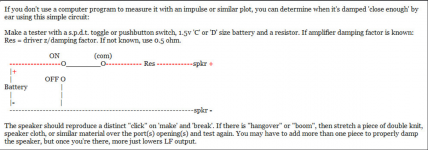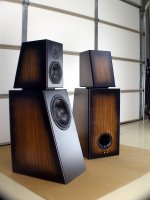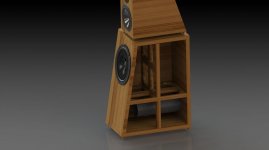Hi,
I've done some experiments recently and did lots of reading but there are knowledgeable people here some of who could give you more hints
Here is mine: put it somewhere else than front if intended speaker placement in your room allows it (some clearance between the port output and wall / floor).
Long story:
since you posted this to multi way forum I suspect your crossover to mid / tweeter is higher than typical ~100Hz for a subwoofer. All you want from the port is to extend the bass response of the woofer. Unfortunately all kinds of other sounds (resonances) from inside the enclosure will pass through the port as well, that you don't want or need. With subwoofers this unwanted output (resonances) are mostly out of band and not audible but when one crossovers higher (typical multiway speaker) resonances may fall into the woofer pass band. There are multiple ways to reduce unwanted sounds from the port.
Standing waves develop in the enclosure as well as in the port itself. These show up as peaks in frequency response measured from the port and may be even louder than the intended Helmholtz resonance you are after.
Best thing you can do is to push all resonances in the box and port as high in frequency as you can so that most of them would not fall into the pass band of the woofer. Stuffing / lining in the enclosure is more effective the higher the frequency. Also, if the port is not in the front panel the higher frequency output is further reduced before hitting your ear.
You should also use smallest port you can get away with (mind air velocity in the port). Smaller and shorter port has higher pipe resonance frequency, possibly out of band, and it acts as acoustic low pass filter for the sounds from inside the enclosure. Also, it seems that placing the port inlet to a pressure node of a standing wave will let it more through than if the inlet was in a velocity node. Thus, best not to put the port inlet against enclosure wall where it is all pressure nodes or 1/2 or 1/4 way where the lowest harmonic pressure nodes should be. Maybe 1/5 or 1/3 along any dimension is most practical. I would guess one shouldn't put the port directly behind the driver.
Keep any enclosure dimension shortest possible. You can cancel out the first enclosure dimension related standing waves by placing the driver midway the enclosure. Simulate this with Hornresp MLTL model and see for yourself.
All this might be unnecessary tweaks. If you got time build a adjustable prototype measure and listen If in hurry I'd say stick the woofer middle of the front panel and port 1/5 way at the back panel and add stuffing on some walls and concentrate all efforts designing the crossover. If the port output ends up being a problem try to figure out what is the cause and target that specifically. One could add a fold or perforations to the port for example. Don't forget to add roundovers both ends of the port.
If in hurry I'd say stick the woofer middle of the front panel and port 1/5 way at the back panel and add stuffing on some walls and concentrate all efforts designing the crossover. If the port output ends up being a problem try to figure out what is the cause and target that specifically. One could add a fold or perforations to the port for example. Don't forget to add roundovers both ends of the port.
Peace
I've done some experiments recently and did lots of reading but there are knowledgeable people here some of who could give you more hints
Here is mine: put it somewhere else than front if intended speaker placement in your room allows it (some clearance between the port output and wall / floor).
Long story:
since you posted this to multi way forum I suspect your crossover to mid / tweeter is higher than typical ~100Hz for a subwoofer. All you want from the port is to extend the bass response of the woofer. Unfortunately all kinds of other sounds (resonances) from inside the enclosure will pass through the port as well, that you don't want or need. With subwoofers this unwanted output (resonances) are mostly out of band and not audible but when one crossovers higher (typical multiway speaker) resonances may fall into the woofer pass band. There are multiple ways to reduce unwanted sounds from the port.
Standing waves develop in the enclosure as well as in the port itself. These show up as peaks in frequency response measured from the port and may be even louder than the intended Helmholtz resonance you are after.
Best thing you can do is to push all resonances in the box and port as high in frequency as you can so that most of them would not fall into the pass band of the woofer. Stuffing / lining in the enclosure is more effective the higher the frequency. Also, if the port is not in the front panel the higher frequency output is further reduced before hitting your ear.
You should also use smallest port you can get away with (mind air velocity in the port). Smaller and shorter port has higher pipe resonance frequency, possibly out of band, and it acts as acoustic low pass filter for the sounds from inside the enclosure. Also, it seems that placing the port inlet to a pressure node of a standing wave will let it more through than if the inlet was in a velocity node. Thus, best not to put the port inlet against enclosure wall where it is all pressure nodes or 1/2 or 1/4 way where the lowest harmonic pressure nodes should be. Maybe 1/5 or 1/3 along any dimension is most practical. I would guess one shouldn't put the port directly behind the driver.
Keep any enclosure dimension shortest possible. You can cancel out the first enclosure dimension related standing waves by placing the driver midway the enclosure. Simulate this with Hornresp MLTL model and see for yourself.
All this might be unnecessary tweaks. If you got time build a adjustable prototype measure and listen
Peace
Last edited:
In that case, you may locate the port where it looks best cosmetically to you.My enclosure will house only the woofer driver.
Just ensure the port will have room to breathe at its exit, i.e. not too close to wall or floor.
Thanks to you both for the input. My heart sank when I read the first post. Another facet of speaker building that is technical and critical. The second post was good news. My reason for asking is that I am looking at an established 3-way design that has the woofer in a separate ported box but doesn't specify exactly where the port is located on the plans. Several builders of the design have placed it somewhere on the back panel but I kind of fancied it up front, but where to place it...................
haha, sorry, i think it is not that critical since there really isn't that much emphasis about the port placement in this forum or if you do some googling. However I think it would be good to take a look where commercial similar sized speakers have their ports placed. I thought to write all info I've gathered lately, for reference.
Good luck with you project!
Good luck with you project!
Simply achieve a symmetrical arrangement of woofer and port openings. If it looks right, it will no doubt sound right!I kind of fancied it up front, but where to place it...
Depending on port resonance frequency you can put it on the front baffle, in some cases mounting on the rear baffle will help and in others it will make a mess where ever you put it. So, with that in mind, at what frequency does your port resonate* ?
*Not to be mistaken for cabinet tuning frequency.
*Not to be mistaken for cabinet tuning frequency.
With modern speakers being narrow and also smaller, there is no place to mount the port on the baffle then it will be to mount it on the back. Then we should not forget that some do not like to see a hole on the front so then design so that the port on the back.
My two cents.
My two cents.
Could it be useful to locate the port on the bottom/underside center shaped like an exponential horn, cab raised/slot all around with swept conical plug matching the port shape and tuning the slot width?Hi,
I've done some experiments recently and did lots of reading but there are knowledgeable people here some of who could give you more hints
Here is mine: put it somewhere else than front if intended speaker placement in your room allows it (some clearance between the port output and wall / floor).
Long story:
since you posted this to multi way forum I suspect your crossover to mid / tweeter is higher than typical ~100Hz for a subwoofer. All you want from the port is to extend the bass response of the woofer. Unfortunately all kinds of other sounds (resonances) from inside the enclosure will pass through the port as well, that you don't want or need. With subwoofers this unwanted output (resonances) are mostly out of band and not audible but when one crossovers higher (typical multiway speaker) resonances may fall into the woofer pass band. There are multiple ways to reduce unwanted sounds from the port.
Standing waves develop in the enclosure as well as in the port itself. These show up as peaks in frequency response measured from the port and may be even louder than the intended Helmholtz resonance you are after.
Best thing you can do is to push all resonances in the box and port as high in frequency as you can so that most of them would not fall into the pass band of the woofer. Stuffing / lining in the enclosure is more effective the higher the frequency. Also, if the port is not in the front panel the higher frequency output is further reduced before hitting your ear.
You should also use smallest port you can get away with (mind air velocity in the port). Smaller and shorter port has higher pipe resonance frequency, possibly out of band, and it acts as acoustic low pass filter for the sounds from inside the enclosure. Also, it seems that placing the port inlet to a pressure node of a standing wave will let it more through than if the inlet was in a velocity node. Thus, best not to put the port inlet against enclosure wall where it is all pressure nodes or 1/2 or 1/4 way where the lowest harmonic pressure nodes should be. Maybe 1/5 or 1/3 along any dimension is most practical. I would guess one shouldn't put the port directly behind the driver.
Keep any enclosure dimension shortest possible. You can cancel out the first enclosure dimension related standing waves by placing the driver midway the enclosure. Simulate this with Hornresp MLTL model and see for yourself.
All this might be unnecessary tweaks. If you got time build a adjustable prototype measure and listenIf in hurry I'd say stick the woofer middle of the front panel and port 1/5 way at the back panel and add stuffing on some walls and concentrate all efforts designing the crossover. If the port output ends up being a problem try to figure out what is the cause and target that specifically. One could add a fold or perforations to the port for example. Don't forget to add roundovers both ends of the port.
Peace
In that case, you may locate the port where it looks best cosmetically to you.
Just ensure the port will have room to breathe at its exit, i.e. not too close to wall or floor.
Not necessarily since we don't know the size, shape of the box nor its XO point/slope as tmuikku's post rightly points out that all this can matter.
If it's a typical relatively small cube or mildly rectangular cab and doesn't have a real long, large a vent, then sure, it doesn't matter where on it the woofer, vent is since it should have a ~uniform particle density and a bit of damping should quell any cab eigenmodes, woofer HF and if the vent is large, long enough to have audible pipe harmonics, then critically damping the vent per below or using an impulse response is a good plan.
GM
Attachments
Could it be useful to locate the port on the bottom/underside center shaped like an exponential horn, cab raised/slot all around with swept conical plug matching the port shape and tuning the slot width?
There's been consumer cabs over the years with this type port [some conical, some expo, some parabolic] to gain a significant amount of driver loading where Fb = Fs, though best suited for either short vents or designed for sub woofer horns like Bruce Edgar did, though according to one owner, a real PITA to integrate into a room, full horn system.
GM
- Status
- This old topic is closed. If you want to reopen this topic, contact a moderator using the "Report Post" button.
- Home
- Loudspeakers
- Multi-Way
- Port position



